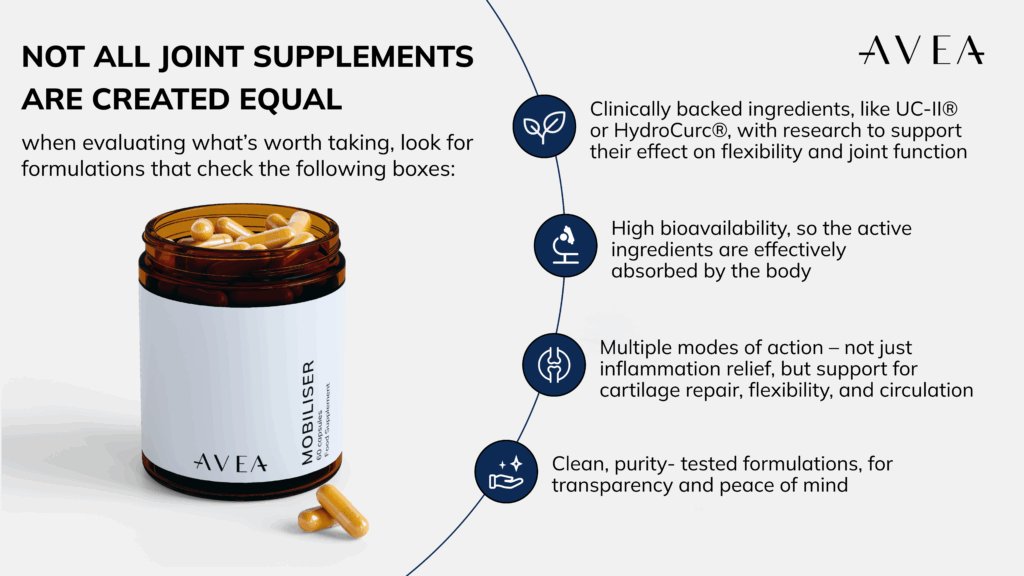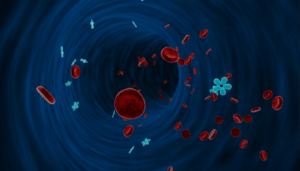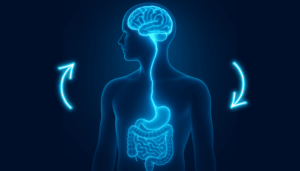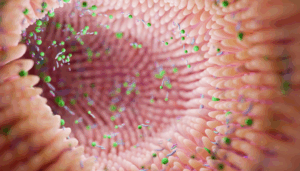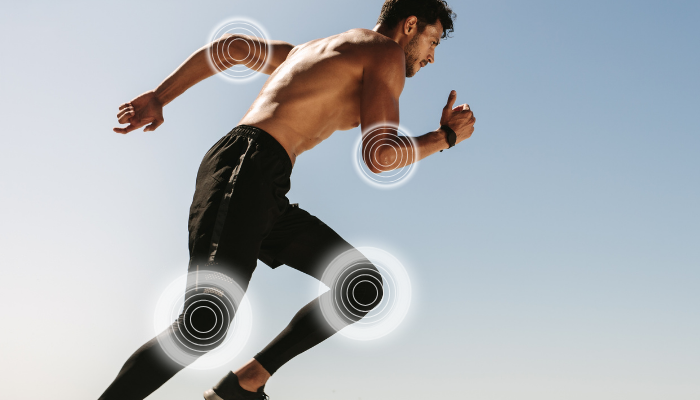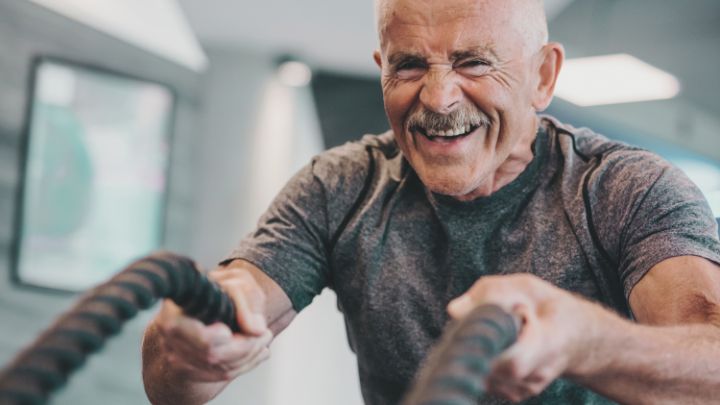Whether you’re lifting weights, going for a long walk, or just staying active throughout the day, your body is constantly under physical stress. The ability to move comfortably, without stiffness, soreness, or joint discomfort, is one of the most overlooked foundations for staying mobile and independent as you age.
Muscle soreness after a challenging workout is a normal part of physical adaptation. But when joint discomfort appears even without exercise, or when recovery feels noticeably delayed, it may signal that your body’s natural repair processes are no longer keeping pace, and need targeted support.
Recovery isn’t just about resting, it’s an active, complex process that affects how you move, feel, and perform.
In this article, we explore why post-exercise recovery becomes slower and less efficient with age, where conventional joint solutions often fall short, and what truly supports mobility, flexibility and joint-longevity.
In this article
What happens to your body after you train?
Whether you’re lifting, sprinting, cycling, or doing a HIIT workout, you’re doing more than just building strength or endurance. Every training session triggers a cascade of microscopic changes in your body, and how you recover from them directly impacts how you feel, move, and perform next time.
Here’s what’s happening under the surface:
- When you train, especially with heavy weights or higher-than-usual intensity, your muscle fibres develop microscopic tears. These micro-injuries are a natural and necessary part of building strength, but they trigger an inflammatory response that the body must work to repair.
- At the same time, your connective tissues, such as tendons and ligaments, are placed under significant mechanical stress. This is particularly true during explosive movements, repetitive impact, or exercises that involve high load under tension. Unlike muscles, these tissues have less blood flow and regenerate more slowly, making them more vulnerable to overuse or wear over time.
- Your joints absorb a significant share of the physical strain involved in movement. It’s not just the moving joint that’s affected – the impact reverberates through the entire kinetic chain, from ankles to knees, hips to spine. With repeated strain, even small inefficiencies in movement or alignment can lead to cumulative stress, inflammation, and stiffness.

All of this is intentional. These small forms of physical stress, from microtears in muscle fibres to joint load and tissue strain, are precisely what stimulate your body to adapt. They signal the need for repair, which in turn strengthens muscles, connective tissue, and movement patterns over time.
But this adaptation process comes at a physiological cost. The body initiates a complex cascade of responses: inflammation is triggered to manage tissue damage, oxidative stress increases as free radicals are produced during exertion, and the immune system becomes activated to coordinate repair. While these processes are necessary for recovery and growth, they can also be draining, especially when the body’s ability to regulate them becomes less efficient with age.
Why recovery becomes harder as you age
As we grow older, the body’s ability to recover from physical exertion naturally declines, and it’s more than just a feeling. What used to be brief muscle soreness or slight stiffness can start to last longer and interfere with your daily routine., and limit mobility in ways that weren’t noticeable before. This shift isn’t a matter of motivation or effort, but rather a reflection of deeper biological changes that alter how the body responds to physical stress over time.
Here are five key reasons why recovery becomes more challenging with age:
1. Your collagen production declines
Collagen is often associated with skin, but its role extends far deeper. It is the primary structural protein in joints, tendons, and connective tissues – the internal scaffolding that gives your body strength, stability, and flexibility. As you age, your body’s ability to produce collagen declines steadily. This gradual loss weakens the integrity of these supportive structures, reducing their capacity to absorb impact and recover from physical stress. As a result, your joints feel stiffer and are more prone to discomfort after movement or training.
2. Inflammation becomes more persistent.
With age, low-grade chronic inflammation tends to increase, a subtle but significant shift in the body’s internal balance. As a result, the natural inflammatory response triggered by physical exertion or tissue stress may take longer to resolve. What was once a brief period of soreness or stiffness can now persist, slowing recovery and reducing overall performance. This prolonged inflammatory state places additional strain on both the immune system and the body’s regenerative pathways, making it more difficult to recover fully and efficiently from daily physical demands.
3. Circulation isn’t what it used to be.
As we get older, subtle but important changes begin to take place in the circulatory system. Blood vessels gradually lose their elasticity, and the efficiency of blood flow throughout the body decreases. This has a direct impact on how well oxygen, nutrients, and essential repair signals are delivered to muscles and joints, especially after physical activity. When circulation slows, the recovery process becomes less effective. Tissues take longer to repair, inflammation can linger, and the usual post-exercise soreness may last well beyond what we’re used to.
4. Cellular repair slows down.
As you age, the biological systems that power recovery begin to slow down. Your mitochondria – the energy-producing structures inside your cells – become less efficient, meaning there’s less cellular energy (ATP) available to fuel critical repair processes. At the same time, natural cell turnover slows, and the rate of tissue regeneration declines. That means damaged muscle fibres take longer to rebuild, and connective tissue like tendons or cartilage isn’t restored as quickly.
5. Joint cartilage wears down.
Cartilage, the smooth, elastic tissue that cushions your joints, gradually becomes thinner and less resilient with age. Over time, it loses moisture and structural integrity, making joints more vulnerable to stress. When you add the repeated impact of training, even healthy joints can begin to feel stiff, sensitive, or less mobile. You might not have an injury in the clinical sense – but gradual strain adds up, and over time, it can subtly affect how you move, recover, and perform.
None of this means you need to train less, but it does mean recovery needs to be approached more intelligently. This is where targeted joint support solutions can offer meaningful help, though it’s important to recognise that not all are equally effective.

Why not all joint supplements offer the same level of support
When we are younger,common strategies like rest, stretching, or a post-workout protein shake might be enough to support recovery. But as we age, the biology of joints changes significantly and with it, the demands of maintaining mobility, flexibility, and comfort.
Hence, many tend to turn to well-known solutions such as :
- Physical therapy and mobility work: These help improve joint stability and alignment by strengthening the muscles around the joints and maintaining healthy movement patterns, but they require ongoing effort and do not address underlying biological processes such as inflammation or tissue repair.
- Red light therapy: By stimulating mitochondrial activity and cellular regeneration, red light therapy can support joint recovery at a local level. However, the effects are often temporary and limited to the treated area.
- Cryotherapy: Regular cold exposure may help reduce post-exercise inflammation and provide short-term relief from joint discomfort, but it does not address the chronic, age-related changes that drive joint stiffness and slower recovery.
- Collagen supplements: Collagen provides structural building blocks for cartilage and connective tissue, which can support joint integrity, but on its own, it doesn’t influence inflammation, oxidative stress, or circulation.
- Joint support supplements: Targeted supplements can offer a convenient and consistent way to support joint function, especially when they include clinically backed ingredients that address inflammation, tissue regeneration, and oxidative stress.
In recent years, joint supplements have become increasingly popular as a convenient way to maintain joint health and resilience over time. Typical joint support powders often rely on well-known ingredients like glucosamine, chondroitin, vitamin C or omega‑3 fatty acids. Glucosamine and chondroitin, in particular, are structural components of cartilage and have long been marketed for joint comfort and mobility. However, their effectiveness remains questionable.
A large network meta-analysis published in the BMJ including over 3,800 patients found no clinically relevant benefit of glucosamine, chondroitin, or their combination compared to a placebo. The authors concluded that these supplements did not reduce joint pain or improve joint function in a meaningful way.
In other words: The standard ingredients fall short, especially when it comes to supporting joint health with age. What’s missing is a more advanced, targeted approach to joint support, which is exactly why we developed our Mobiliser.
The Mobiliser: Smarter support for muscles, joints & connective tissues
We developed our Mobiliser in collaboration with longevity experts in Switzerland to support post-exercise recovery from multiple angles: muscular, joint, and connective tissue.
It combines three innovative active ingredients with clinically relevant co-factors, going far beyond traditional substances like glucosamine or chondroitin. Each component was chosen to target a different aspect of joint health and mobility, allowing for a comprehensive solution.
Here’s what’s inside AVEA’s Mobiliser and how it works:
1. HydroCurc® (500mg): Curcumin extract for inflammation, soreness & recovery
Curcumin is a powerful natural compound with well-documented anti-inflammatory effects. But most forms of curcumin are poorly absorbed, HydroCurc® uses advanced LipiSperse® technology to dramatically improve bioavailability, making it one of the most effective curcumin ingredients available today.
What the research shows: In a clinical trial, healthy men who took 500 mg of HydroCurc® before and after a heavy leg workout experienced less delayed onset muscle soreness (DOMS), lower lactate levels (less fatigue), reduced inflammation markers and the activation of the mTOR pathway – essential for muscle repair and growth.
Faster recovery = better training consistency. HydroCurc® helps the body calm inflammation, reduce soreness, and potentially accelerate muscle repair.
2. Maritime Pine Bark Extract (200mg) – For Circulation & Oxidative Stress
Recovery isn’t just about rebuilding, it’s also about clearing out what’s been broken down. Efficient blood flow delivers nutrients and removes waste products such as lactate and free radicals. Maritime pine bark extract contains OPCs (oligomeric proanthocyanidins). These are potent antioxidants that support vascular health and reduce exercise-induced oxidative stress.
What the research shows: A study indicated that daily supplementation improved markers of post-exercise recovery, including reduced inflammation and soreness, lower oxidative stress and enhanced blood flow and tissue repair.
More circulation = more nutrients where they’re needed, and faster clearance of what slows you down. Maritime pine bark extract supports this process by improving blood flow and providing antioxidant protection.
3. UC-II® (40μg) – Collagen for Joint Recovery & Long-Term Mobility
Most joint supplements rely on generic hydrolysed collagen, but UC-II® is different. It’s a patented form of undenatured type II collagen that works by modulating the immune response, helping your body stop attacking its own cartilage.
What the research shows: In a study UC-II® improved joint comfort, flexibility, and range of motion, better endurance and reduced joint stiffness with regular use in 120 days.
Healthier, stronger joints = more freedom to move, train, and stay active — with less stiffness holding you back. UC-II® supports that freedom from within.
4. Vitamin C (120mg) – A Collagen Co-Factor & Antioxidant Powerhouse
Even with plenty of collagen in your system, your body can’t use it properly without enough vitamin C. It’s the missing link in many recovery routines — and crucial for repairing tissue after physical strain.
What the research shows: A clinical review showed that Vitamin C supports collagen regeneration in muscle and connective tissue, reduction of free radicals after exercise and faster repair of musculoskeletal strain.
Better collagen support = stronger, more resilient joints, muscles, and connective tissue. Vitamin C plays a key role in making that possible. It’s an essential co-factor in collagen synthesis and a powerful antioxidant that helps neutralise free radicals generated during exercise.
Did you conduct research studies on the effectiveness of the Mobiliser? Yes, in our internal studies, users reported significant improvements in joint and physical performance. After three months:
- Participants experienced a 50% improvement in overall joint wellbeing and
- a 56% reduction in joint stiffness
measured by the validated WOMAC index (N = 21).
In a separate customer survey,
- 80% reported enhanced physical performance within just 30 days, and
- 77% noticed improved physical endurance after the same period (N = 47).
These results highlight the potential of AVEA’s Mobiliser to significantly support your recovery, mobility, and long-term joint resilience.
Our Mobiliser helps you stay active, mobile, and resilient – at any age. Try it risk-free with our 90-day satisfaction guarantee and experience the difference it can make for your recovery and joint health.
Tip: For extra-strength joint support, combine Mobiliser with our Collagen Activator to naturally boost collagen production even further. AVEA’s Collagen Activator is based on Colgevity®, a clinically studied collagen precursor shown to be 4× more effective at stimulating collagen production than standard collagen supplements. For best results – and better value – both supplements are also available as a duo in our Mobility Routine Duo.
